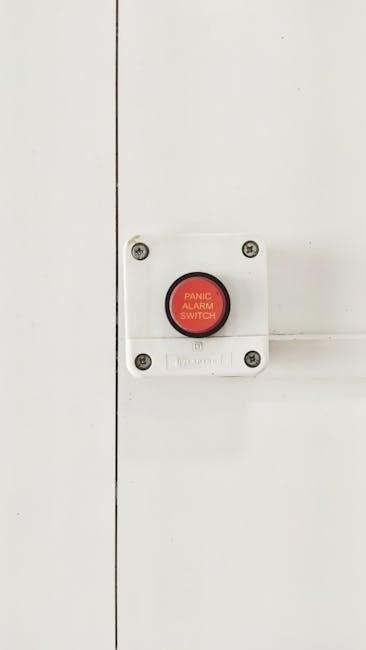The Honeywell TH5220D1003 is a digital programmable thermostat designed for efficient HVAC system control. It offers advanced features, easy installation, and energy-saving capabilities, making it a popular choice for modern homes.
1.1 Overview of the Honeywell TH5220D1003 Thermostat
The Honeywell TH5220D1003 is a digital programmable thermostat designed for precise temperature control and energy efficiency. Featuring a user-friendly interface, it allows for customizable scheduling and seamless integration with HVAC systems. This thermostat is compatible with a wide range of heating and cooling systems, making it a versatile choice for various home setups. Its sleek design and touch screen display enhance ease of use, while advanced features like programmable schedules and energy-saving modes help reduce utility bills. The TH5220D1003 is ideal for homeowners seeking a reliable and modern solution for temperature management.
1.2 Importance of the Installation Manual
The installation manual for the Honeywell TH5220D1003 is essential for ensuring proper setup and functionality. It provides step-by-step instructions, safety guidelines, and troubleshooting tips, helping users avoid common mistakes. By following the manual, homeowners can optimize the thermostat’s performance, ensuring energy efficiency and system compatibility. The manual also serves as a reference for understanding advanced features and maintaining the thermostat over time. Adhering to the instructions helps prevent potential issues, ensuring a smooth and safe installation process while maximizing the device’s capabilities and extending its lifespan.

Pre-Installation Requirements
Before installing the Honeywell TH5220D1003, verify system compatibility, gather necessary tools, and ensure electrical requirements are met. This ensures a smooth and safe installation process.
2.1 Compatibility Check for the Honeywell TH5220D1003
Ensure the Honeywell TH5220D1003 is compatible with your HVAC system. Verify voltage requirements and system type (e.g., heat pump, gas, or electric). Check wiring configuration and ensure it matches the thermostat’s terminal connections. Compatibility is crucial for proper functionality and safety. Refer to the installation manual for detailed specifications and system requirements. Incorrect installation due to incompatibility can lead to performance issues or safety hazards. Always confirm compatibility before proceeding with installation.
2.2 Tools and Materials Needed for Installation
To install the Honeywell TH5220D1003, gather necessary tools and materials. You’ll need a Phillips screwdriver for removing the old thermostat and mounting the new one. Wire strippers may be required if you need to trim or connect wires. A drill and bits are essential for making holes in the wall for mounting screws. Ensure you have wall anchors for secure installation, especially in drywall. Additionally, check if the thermostat requires batteries and have them ready. A voltage tester is crucial to ensure power is off before handling wires. Cable ties can help organize wires neatly, and a level ensures the thermostat is mounted straight. Refer to the installation manual for specific requirements to avoid missing any essential items.

Step-by-Step Installation Guide
This guide provides a straightforward approach to installing the Honeywell TH5220D1003. Follow the detailed steps to prepare the site, mount the thermostat, connect wires, and power it on.
3.1 Preparing the Site for Installation
Before installing the Honeywell TH5220D1003, ensure the site is ready. Turn off the power to the HVAC system at the circuit breaker. Remove the old thermostat carefully, taking note of the wiring connections. Clean the wall area where the new thermostat will be mounted to ensure proper adhesion. Gather all necessary tools and materials, such as a screwdriver, drill, and wall anchors, if required. Verify that the system is compatible with the Honeywell TH5220D1003 to avoid any installation issues. Ensure the area is clear of debris and obstacles for a smooth installation process.
3.2 Mounting the Thermostat
Mount the Honeywell TH5220D1003 thermostat by first attaching the base plate to the wall. Ensure the base is level and mark the wall for drilling. Use wall anchors if necessary and secure the base plate with screws. Once the base is firmly attached, align the thermostat with the base and gently snap it into place. Make sure it clicks securely to ensure proper installation. Double-check that the thermostat is level and properly aligned before proceeding to the wiring step. A correctly mounted thermostat ensures accurate temperature readings and optimal performance.
3.3 Connecting the Wires
Begin by turning off the power to your HVAC system at the circuit breaker. Locate the wires from your system and match them to the thermostat terminals. Typically, the blue wire connects to the common (C) terminal, the red wire to the heating (R) terminal, the yellow wire to the cooling (Y) terminal, and the green wire to the fan (G) terminal. If you have a dual-fuel system or heat pump, additional wires may be required. Refer to the wiring diagram in the manual for specific configurations. Securely attach each wire to the corresponding terminal, ensuring no loose connections. Once all wires are connected, restore power and test the thermostat to confirm proper functionality. If issues arise, double-check your connections or consult a professional for assistance.
3.4 Powering On the Thermostat
Once all wires are securely connected, restore power to your HVAC system by switching the circuit breaker back to the “on” position. The thermostat’s display should illuminate, indicating it has power. If the display remains blank, check your wiring connections and ensure the circuit breaker is fully engaged. Use the manual to navigate through the initial setup options, such as setting the date, time, and preferred temperature range. Test the thermostat by switching between heating and cooling modes to confirm proper functionality. If issues arise, refer to the troubleshooting section of the manual or consult a licensed professional for assistance.

Wiring Diagram and Connections
The wiring diagram provides a clear visual guide for connecting your Honeywell TH5220D1003 thermostat. Ensure all wires are securely attached to the correct terminals for proper functionality and safety.
4.1 Understanding the Wiring Diagram
The wiring diagram is a essential tool for installing the Honeywell TH5220D1003. It provides a visual representation of the thermostat’s connections, ensuring proper wiring. Each terminal (R, W, Y, G, C, etc.) is labeled to match your HVAC system. Understanding the diagram helps identify the correct wires for heating, cooling, and fan functions. Color-coding and symbols are used to simplify the process. Always refer to the diagram to avoid misconnections, which could damage the thermostat or HVAC system. Take your time to study and decode the symbols for a seamless installation experience.
4.2 Connecting the Wires to the Correct Terminals
When connecting wires to the Honeywell TH5220D1003, ensure each wire is securely attached to the correct terminal. Refer to the wiring diagram to match your system’s wiring with the thermostat’s terminals (R, W, Y, G, C, etc.). Turn off the power supply before starting to avoid electrical hazards. Incorrect connections can lead to malfunction or damage. Use needle-nose pliers for precise wiring and double-check each connection for accuracy. This step is critical for proper thermostat operation and HVAC system control. Taking your time ensures reliability and prevents future issues.

Programming the Honeywell TH5220D1003
Programming the Honeywell TH5220D1003 allows for customized temperature settings and schedules. The user-friendly interface simplifies setting up daily and weekly preferences, optimizing comfort and energy efficiency.
5.1 Setting Up the Initial Configuration
Setting up the initial configuration on the Honeywell TH5220D1003 involves basic settings like date, time, and temperature units. Start by powering on the thermostat and following the on-screen prompts. Use the navigation keys to adjust settings. Ensure the time and date are accurate for proper scheduling. Select your preferred temperature unit (Fahrenheit or Celsius). These initial steps prepare the thermostat for programming. Once complete, you can proceed to create schedules or adjust settings for optimal performance. Proper initial setup ensures smooth operation and energy efficiency. This process is straightforward, even for first-time users.
5.2 Creating a Weekly Schedule
Creating a weekly schedule on the Honeywell TH5220D1003 allows you to customize temperature settings for different days and times. Start by accessing the menu and selecting the “Schedule” option. Choose the day(s) you want to program and set the desired wake, leave, return, and sleep times. Adjust the temperature levels for each segment to suit your comfort and energy-saving needs. The thermostat allows you to copy schedules across multiple days for convenience; Once programmed, the system will automatically adjust temperatures according to your schedule. This feature ensures optimal comfort and energy efficiency throughout the week. Regularly review and update your schedule as needed.

Advanced Features of the Honeywell TH5220D1003
The Honeywell TH5220D1003 offers advanced features like smart home integration and energy-saving modes. It supports remote access and geofencing, enhancing convenience and efficiency for users.
6.1 Smart Home Integration
The Honeywell TH5220D1003 seamlessly integrates with popular smart home systems, allowing users to control their HVAC system through voice commands or smartphone apps. This feature enhances convenience and flexibility, enabling users to adjust temperatures remotely. Compatibility with platforms like Amazon Alexa and Google Home ensures easy integration into existing smart home setups. Additionally, smart home integration allows for geofencing, automatically adjusting temperatures based on your location, optimizing energy use and comfort. This advanced feature makes the Honeywell TH5220D1003 a modern and efficient choice for smart home enthusiasts.
6.2 Energy-Saving Modes
The Honeywell TH5220D1003 features energy-saving modes designed to reduce energy consumption while maintaining comfort. The thermostat includes an energy-saving mode that adjusts temperatures slightly when the system is inactive, minimizing energy use. Additionally, the programmable schedule allows users to set energy-efficient temperature settings during off-peak hours or when the home is unoccupied. The auto-changeover feature ensures efficient operation by automatically switching between heating and cooling systems based on the set temperature. These modes help users save energy and lower utility bills without sacrificing comfort, making the Honeywell TH5220D1003 an eco-friendly and cost-effective solution.

Maintenance and Troubleshooting
Regular maintenance ensures optimal performance. Troubleshooting helps identify and resolve issues promptly, keeping the thermostat functioning efficiently and extending its lifespan.
7.1 Regular Maintenance Tips
Regular maintenance ensures the Honeywell TH5220D1003 operates efficiently. Clean the thermostat with a soft cloth to prevent dust buildup. For non-wireless models, check and replace batteries every 5 years. Inspect wiring for wear or damage. Update software periodically to access new features. Calibrate temperature settings annually for accuracy. Refer to the installation manual for specific maintenance schedules and guidelines to ensure optimal performance and prevent potential issues.
7.2 Common Issues and Solutions
Common issues with the Honeywell TH5220D1003 include display not turning on, incorrect temperature readings, or unresponsiveness. For a blank display, check power sources and ensure circuit breakers are on. If temperature is off, calibrate the thermostat. Unresponsiveness may require resetting the system by removing batteries or disconnecting power temporarily. Wiring issues can cause malfunction; verify connections using the wiring diagram. For Wi-Fi models, connectivity problems may require restarting the router or reconfiguring network settings. Consult the manual or contact support for unresolved issues to ensure proper functionality.

Safety Precautions
Safety is crucial. Always turn off power before installation. Handle the thermostat carefully to avoid damage. Follow all electrical guidelines to prevent hazards. Ensure proper installation for reliability.
8.1 Electrical Safety Guidelines
Before starting, ensure the power to your HVAC system is turned off at the circuit breaker. Verify the system voltage matches the thermostat’s rating (24V AC). Avoid touching live wires, and use insulated tools to prevent electrical shock. Ground yourself properly to prevent static discharge. Never bypass safety devices or ignore warning labels. If unsure, consult a licensed electrician. Always follow local electrical codes and manufacturer instructions to ensure safe installation and operation of the Honeywell TH5220D1003 thermostat.
8.2 Handling the Thermostat Safely
Handle the Honeywell TH5220D1003 thermostat with care to avoid damage. Always use an anti-static strap or ground yourself to prevent static discharge, which can harm the electronic components. Avoid touching sensitive parts like the circuit board or wires. Clean the thermostat gently with a soft, dry cloth, avoiding harsh chemicals. Keep it away from children to prevent accidental damage. Before installation, inspect for visible damage and ensure all parts are intact. Store unused components in the original packaging. Follow the manufacturer’s guidelines for handling and installation to ensure safety and proper function.

Frequently Asked Questions
Find answers to common questions about the Honeywell TH5220D1003 installation, troubleshooting, and features to ensure a smooth setup and optimal performance of your thermostat.
9.1 Common Questions About Installation
Users often inquire about compatibility, wiring, and tools required for installing the Honeywell TH5220D1003. Is it compatible with their HVAC system? Do they need a C-wire? What tools are necessary? The installation manual provides detailed compatibility checks and lists essential tools like screwdrivers and wire strippers. Wiring diagrams are included to simplify connections, ensuring proper terminal assignments. Mounting the thermostat involves removing the old one and transferring wires carefully. If unsure, consulting a professional is recommended. The manual guides users through each step to ensure a smooth installation process and proper system functionality.
9.2 Troubleshooting Frequently Asked Questions
Common issues during installation include the thermostat not turning on, incorrect temperature readings, or unresponsive screens. Check if the power source is stable and wires are securely connected. Ensure the circuit breaker isn’t tripped. Verify wiring connections match the diagram in the manual. If the display is blank, confirm the thermostat is properly powered. For temperature inaccuracies, recalibrate the sensor through the menu. If problems persist, reset the thermostat by removing batteries or power for 30 seconds; Refer to the troubleshooting section in the manual for detailed solutions or contact Honeywell support for assistance.
The Honeywell TH5220D1003 installation process is straightforward when following the manual, ensuring optimal performance and energy efficiency for your heating and cooling system. Proper setup guarantees enhanced comfort and energy savings, making it a valuable addition to any smart home system.
10.1 Summary of Key Points
The Honeywell TH5220D1003 installation manual provides a comprehensive guide for successful setup and operation. Key steps include compatibility checks, proper wiring connections, and programming schedules. Ensuring electrical safety and following maintenance tips is crucial for longevity. The thermostat offers advanced features like energy-saving modes and smart home integration. By adhering to the manual, users can optimize heating and cooling efficiency, reducing energy costs while maintaining comfort. Refer to additional resources for troubleshooting or further customization needs.
- Compatibility and wiring are critical for proper function.
- Regular maintenance ensures optimal performance.
- Energy-saving features enhance efficiency and comfort.

Additional Resources
Visit Honeywell’s official website for the TH5220D1003 installation manual PDF. Explore support forums, FAQs, and contact customer service for further assistance.
- Download the manual here
- Honeywell Support Portal
- Authorized Dealers
11.1 Where to Find More Information
For detailed guidance, download the Honeywell TH5220D1003 installation manual PDF from Honeywell’s official website or authorized dealer sites. Visit Honeywell’s support page for FAQs, troubleshooting guides, and video tutorials. Additionally, check retailer websites like Amazon or Home Depot, which often provide downloadable resources. For personalized assistance, contact Honeywell’s customer support team directly. Ensure you only use official sources to avoid incorrect or outdated information.
- Honeywell Official Website
- Authorized Dealers
- Support Forums
- Customer Support



